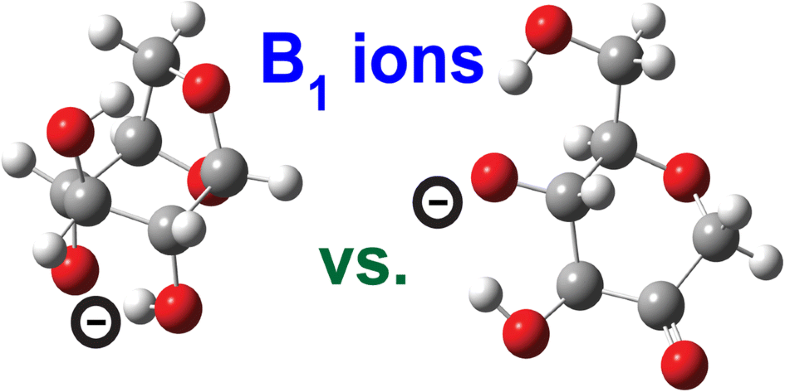Journal of the American Society for Mass Spectrometry ( IF 3.2 ) Pub Date : 2018-10-03 , DOI: 10.1007/s13361-018-2065-0 Benjamin J. Bythell 1 , Jordan M. Rabus 1 , Ashley R. Wagoner 1 , Maha T. Abutokaikah 1 , Philippe Maître 2
We investigate the tandem mass spectrometry of regiospecifically labeled, deprotonated sucrose analytes. We utilize density functional theory calculations to model the pertinent gas-phase fragmentation chemistry of the prevalent glycosidic bond cleavages (B1-Y1 and C1-Z1 reactions) and compare these predictions to infrared spectroscopy experiments on the resulting B1 and C1 product anions. For the C1 anions, barriers to interconversion of the pyranose [α-glucose-H]−, C1 anions to entropically favorable ring-open aldehyde-terminated forms were modest (41 kJ mol−1) consistent with the observation of a band assigned to a carbonyl stretch at ~ 1680–1720 cm−1. For the B1 anions, our transition structure calculations predict the presence of both deprotonated 1,6-anhydroglucose and carbon 2-ketone ((4S,5S,6R)-4,5-dihydroxy-6-(hydroxymethyl)dihydro-2H-pyran-3(4H)-one) anion structures, with the latter predominating. This hypothesis is supported by our spectroscopic data which show diagnostic bands at 1600, 1674, and 1699 cm−1 (deprotonated carbon 2-ketone structures), and at ~ 1541 cm−1 (both types of structure) and RRKM rate calculations. The deprotonated carbon 2-ketone structures are also the lowest energy product B1 anions.

ᅟ
中文翻译:

去质子化蔗糖阴离子的序列离子结构和解离化学
我们研究了区域特异性标记的去质子化蔗糖分析物的串联质谱。我们利用密度泛函理论计算来模拟流行的糖苷键裂解(B 1 -Y 1和C 1 -Z 1反应)的相关气相裂解化学,并将这些预测与红外光谱实验对所得的B 1和C进行比较1个产品负离子。对于C 1阴离子,是吡喃糖[α-葡萄糖-H] -,C 1相互转化的障碍阴离子为熵有利的开环醛末端形式是适度的(41 kJ mol -1),与在〜1680–1720 cm -1处分配给羰基的谱带的观察结果一致。对于B 1阴离子,我们的过渡结构计算预测了去质子化的1,6-脱水葡萄糖和碳2-酮((4S,5S,6R)-4,5-二羟基-6-(羟甲基)二氢-2H- pyran-3(4H)-one)阴离子结构,其中后者占主导地位。这一假设是由我们其中在1600,1674显示诊断条带的光谱数据,并且1699厘米支持-1(去质子化的碳-2-酮结构),并在〜1541厘米-1(两种类型的结构)和RRKM速率计算。去质子化的碳2-酮结构也是能量最低的产物B 1阴离子。

ᅟ



























 京公网安备 11010802027423号
京公网安备 11010802027423号